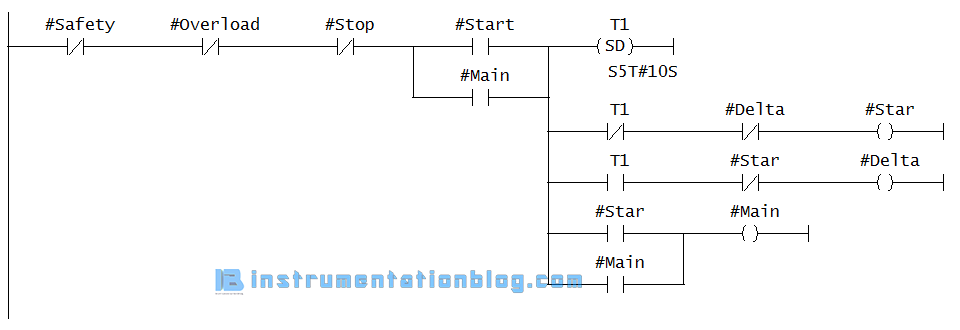In Electrical Engineering, the most basic topic is Electrical Motor. If you want to drive any mechanical equipment then you have to connect it with Electric Motor.
To drive this Electric Motor, we need Motor Starter.
So, In this blog, we are going to see the What is Motor Starter, Types of Starter and Why do we need starters to start any motor?
Additional to this we will also cover the basic conversion of this motor starter into PLC Programming using Ladder Logic.
Why do we need a Motor Starter?
As we all know that when we supplied a 3-phase supply for the starting of induction motor. Initially, it will take a huge amount(normally 5-8 times more than it’s rated) current. This current reduces as the motor achieves it’s running speed.
This huge current can damage the motor windings. It also generates a voltage dip on the supply line which might result in the malfunction of other connected electrical equipment.
Therefore, Starter is needed to limit the starting current to avoid damage to the motor as well as other connected electrical equipment in the same line supply.
Table of Contents
What is Motor Starter?
The Motor Starter is a device that is used to start and stop the motor to which it is connected.
Normally DOL(Direct On-Line) starter is used to start the motor. But for a heavy motor with more power, other advanced starters like Star-Delta, Soft Starter, and VFD Starter is used.
Advanced starter(like Star-Delta, Soft Starter, VFD Starter) applies less voltage to reduce the high initial current, this voltage reduction is for a short time. As the motor accelerates to its running speed, full voltage is applied to the motor.
The motor starter provides other functionality also to protect the motor from any other fault like overload, single phasing, under-voltage, voltage unbalance, stall protection.
There are many types of starter used to start the motor, in this blog we are going to see some basic motor starters and their conversion in PLC ladder logic.
1) DOL Starter
DOL stands for Direct Online Starter, most commonly used in the industry to start the motor.
In this method, full voltage is applied to the motor, but the starting current would be very high(usually 5-8 times more than it’s rated current). For a low capacity motor, there is no need to reduce the voltage at the starting.
Although, it provides all other functionality like overloading, single phasing, and low voltage.
To develop the PLC ladder logic of the DOL starter, first, we have to look at the control circuit of this starter.

Advantages:
- Cost-Effective
- Simple in Construction
Disadvantages:
- Initial high current
- Unable to use on Heavy Motors
Here we have inputs like Start push button, Stop push button, Safety switch, Overload relay, and outputs like contactor and ON/OFF indicator.
The conversion of DOL starter in PLC ladder logic is as below,

2) Forward/Reverse Starter
Forward/Reverse starter is another starter used when we need to change the direction of the motor, Through this starter, it is possible to operate the motor in both directions.
Forward/Reverse starter works on the same principle as the DOL starter, but it has additional functionality to change the direction of the motor.
Here you can find the control and power wiring of this starter.

Advantages:
- Cost-Effective
- Simple in Construction
- High Starting Torque
Disadvantages:
- Initial high current
- Unable to use on Heavy Motors
Here we have inputs like Start forward, start to reverse and stop pushbuttons, Safety switch, Overload relay, and outputs like forward and reverse contactors.
The conversion of Forward/Reverse starter in PLC ladder logic is as below,

3) Star-Delta Starter
Star-Delta starter is used for heavy motors applications like Pump, Blower, Crusher, etc.
Star-Delta starter supplies a low voltage initially at the start, this reduces a torque also. This starter uses a timer, contactor, overload, etc.
In this starter, Star connection is used at the start and Delta connection is used for a normal run.

Star-Delta Starter
Advantages:
- Low starting current
- Good for long acceleration time
Disadvantages:
- Complex wiring
Here we have inputs like start, stop pushbuttons, safety switch, overload relay, and output like a star, delta, and main contactors.
The conversion of Star-Delta starter in PLC ladder logic is as below,

Final Thoughts
This is all about the basic information about the 3 most common types of electrical motor starters.
I hope you like this blog, If you want a detailed description of the advanced motor starter like a Soft starter, VFD stater then please comment down below.

Great information. Simple to understand presentation. Would also like to see forward and reverse for the star-delta starter (power diagram and ladder logic)
Please refer to this article about the forward/reverse star-delta starter.
Thanks for the feedback.
Amazing tutorial. As a professional who has worked with automatic motor starters including 3 phase automatic motor starter, I must say you’ve explained the working in simple words. Looking forward for more educative posts.
Am very grateful to be part of this group and have now understand a lot of things about motor starters
Thank for this great information
Thanks a lot sir ?
Hi mate,
I would be delighted to read your blog as regards the comment you left at the end of the article.
“I hope you like this blog, If you want a detailed description of the advanced motor starter like a Soft starter, VFD starter then please comment down below.”
I really appreciate your feedback and I will take it as a note for the future blog.